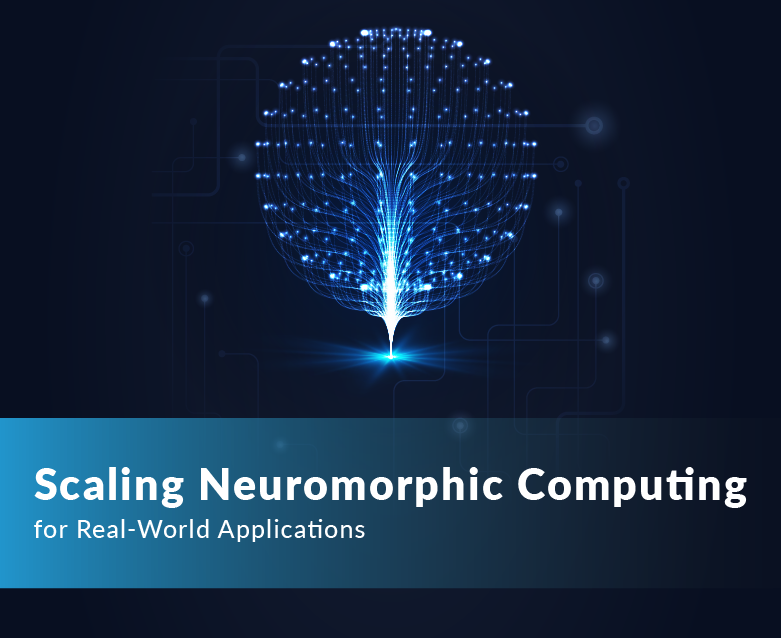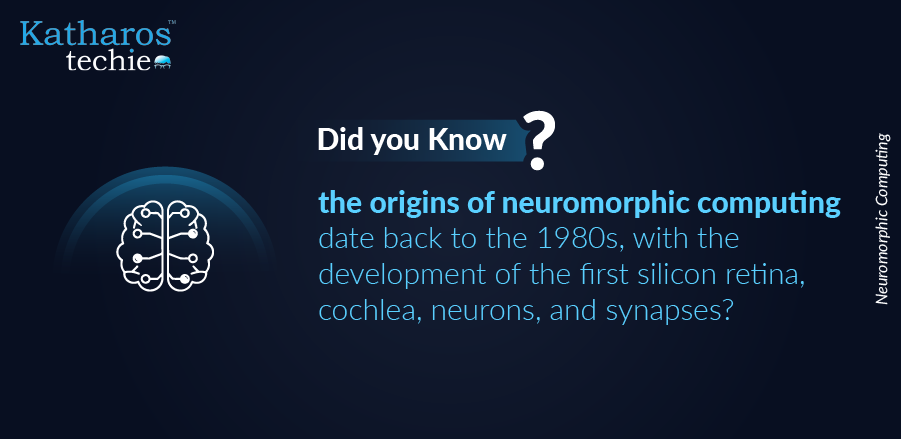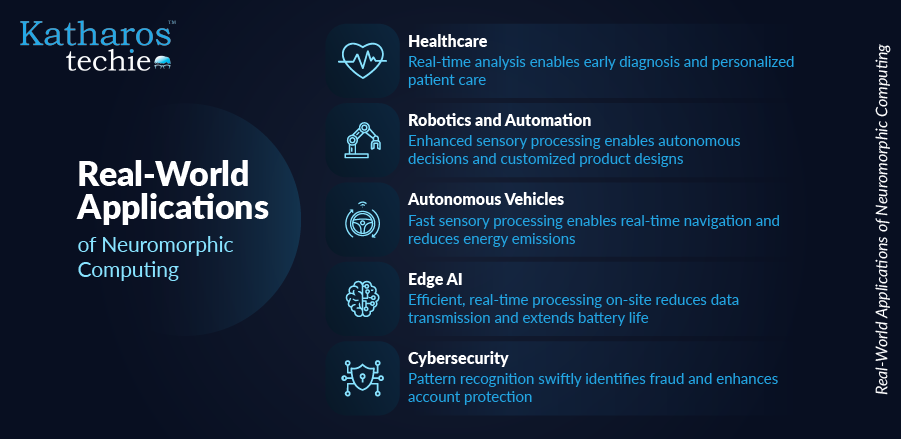
Scaling Neuromorphic Computing for Real-World Applications
By Ankita Das

Neuromorphic computing, inspired by the structure and function of the human brain, is emerging as a next-generation computing paradigm. This innovative approach eliminates the limitations of traditional computing systems in artificial intelligence processing by increasing efficiency, speed, and sustainability. The technology mimics the brain’s neural systems to process information like human cognition.
Experts project neuromorphic computing to grow at a CAGR of 19.9% and exceed $20 billion by 2030, underscoring its potential to revolutionize technology. Neuromorphic devices are designed for real-time learning, adapting, and dynamically improving performance. Universities are advancing neuromorphic computing through research and practical applications, signaling its growing importance.
Soon, this emerging technology will enable computers to think and provide results that resemble human intelligence. This blog will delve into core principles, major benefits, and various real-world applications of this groundbreaking technology.
What is Neuromorphic Computing?

Neuromorphic computing is an innovative approach to computing that draws inspiration from the structure and function of the human brain. It involves designing computer hardware and software to mimic neural and synaptic structures. Neuromorphic computing uses artificial neurons and synapses to process information. These components simulate how the brain processes information, allowing faster and more efficient problem-solving, pattern recognition, and decision-making.
The scale of AI computations is rapidly outpacing the capabilities of conventional computers. Therefore, we need neuromorphic computing to eliminate limitations in handling increasingly complex AI tasks. Many experts believe computing offers a way to overcome these limitations, providing a more advanced approach to data processing. This is because it can significantly accelerate data processing and analysis. The technology’s parallel processing capability handles complex tasks like image recognition and NLP much faster than traditional systems.
Neuromorphic computing helps by offering several key advantages. It integrates memory and processing more closely, reducing the bottlenecks associated with traditional architectures. They also employ an event-driven computational approach, activating only when computation and necessary data are present. This approach results in significantly lowering energy requirements. Moreover, the inherent stochastic nature of neuromorphic systems enables them to handle uncertain and variable real-world data more effectively.
How Does Neuromorphic Computing Differs From Traditional Computing?
To fully leverage the potential of neuromorphic computing, it’s crucial to understand how it diverges from traditional computing. The distinctions lie in their architecture, data processing methods, and energy consumption. The following table highlights these key differences:
| Aspects | Neuromorphic Computing | Traditional Computing |
| Architecture | Mimics the human brain with spiking neural networks (SNNs) | Uses deep neural networks (DNNs) |
| Processing | Event-driven, processing data only when needed | Processes data in a structured, continuous manner |
| Memory | Integrated processing and memory | Separate memory (RAM) and processing units (CPU/GPU) |
| Energy Use | Lower energy consumption | Higher energy consumption |
| Speed | Faster processing for specific tasks like image recognition | Efficient for complex calculations |
Real-World Applications of Neuromorphic Computing

Neuromorphic computing is gaining traction across various sectors. This is attributed to its unique ability to mimic the human brain’s efficiency and adaptability. Below are the real-world applications of neuromorphic computing that help in efficient processing and decision-making.
1. Healthcare
Neuromorphic systems are used for real-time medical data analysis, aiding early diagnosis and personalized treatment plans. They can process data from wearable health monitors to detect subtle changes in patient health and provide instant alerts. Neuromorphic computing improves the analysis of electrocardiogram (ECG) recordings by detecting misclassifications, which is crucial for accurate diagnoses. Its predictive analytics capabilities facilitate the early detection of potential health issues based on historical data patterns, essential for proactive patient care.
2. Robotics and Automation
Neuromorphic computing improves sensory processing and movement control, allowing robots to make autonomous decisions. The parallel processing capabilities of neuromorphic chips allow for real-time adaptation in smart manufacturing systems. Neuromorphic controllers adapt production processes in real time, rather than simply following pre-programmed routines. The pattern recognition capabilities of systems enable more customized and targeted product designs that cater to specific consumer needs.
3. Autonomous Vehicles
The technology processes complex sensory inputs faster, helping autonomous vehicles make real-time navigation decisions. This technology enhances response times and optimizes on-the-go corrections while reducing energy emissions. The ability to process data locally ensures swift decision-making, for safety in autonomous driving. Systems like SpiNNaker use chip architectures that mimic the brain’s neural networks to facilitate massively parallel computing. Thus, reducing data processing lag and enhancing overall system efficiency.
4. Edge AI
Neuromorphic computing’s energy efficiency and real-time processing make it suitable for edge AI. It can process data on-site in IoT devices, reducing the need to transmit data to central servers. This saves bandwidth and reduces latency, making it ideal for applications requiring quick decision-making without cloud connectivity. The energy efficiency extends the battery life of these devices, reducing the need to recharge or replace edge devices.
5. Cybersecurity
Neuromorphic computing excels at recognizing complex patterns, enabling it to identify subtle signs of fraudulent activity or security breaches. It can detect unusual spending behavior or counterfeit login attempts. The low latency processing allows for a better response once fraud has been detected, such as freezing accounts or alerting authorities in real-time.
These applications demonstrate neuromorphic computing’s potential to revolutionize technology by offering efficient, adaptive, and intelligent solutions. Its ability to process data locally, in real-time, and with low power consumption makes it ideal for a wide range of uses.
Final Thoughts
Neuromorphic computing holds immense promise for transforming how we interact with technology and solve complex problems across various sectors. Its brain-inspired architecture allows for flexibility and adaptability that traditional AI systems struggle to achieve. As businesses seek innovative solutions to meet growing demands, neuromorphic computing offers a pathway to enhanced performance and efficiency. Are you ready to explore how neuromorphic computing can transform your business? Contact us today to learn more about implementing emerging technologies tailored to your needs and discover how they can drive your organization into the future.